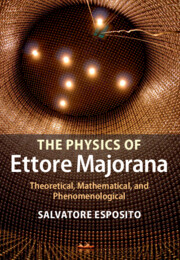Book contents
- Frontmatter
- Contents
- Acknowledgments
- Part I Introducing the character
- Part II Atomic physics
- Part III Nuclear and statistical physics
- 5 Quasi-stationary nuclear states
- 6 Theory of ferromagnetism
- Part IV Relativistic fields and group theory
- Part V Quantum field theory
- Part VI Fundamental theories and other topics
- Part VII Beyond Majorana
- Appendix Molecular bonding in quantum mechanics
- References
- Author index
- Subject index
6 - Theory of ferromagnetism
Published online by Cambridge University Press: 18 December 2014
- Frontmatter
- Contents
- Acknowledgments
- Part I Introducing the character
- Part II Atomic physics
- Part III Nuclear and statistical physics
- 5 Quasi-stationary nuclear states
- 6 Theory of ferromagnetism
- Part IV Relativistic fields and group theory
- Part V Quantum field theory
- Part VI Fundamental theories and other topics
- Part VII Beyond Majorana
- Appendix Molecular bonding in quantum mechanics
- References
- Author index
- Subject index
Summary
At the October 1930 Solvay conference in Paris, Pauli made a comprehensive review of magnetism, including the intriguing results obtained by Heisenberg [246], Bloch [247, 248], and Slater [249] on the phenomenon of ferromagnetism. That meeting was also attended by Fermi, who, very likely, spread the novel results obtained by those scholars within his group in Rome, and Majorana, used as he was to spending time studying papers published by Heisenberg (and a few other authors), probably became (or was already) aware of his theory of ferromagnetism, in which exchange forces again play a key role in the understanding of the phenomenon. Fermi and his close collaborators never worked or published anything on this subject, but several people visiting the Institute of Physics in Rome in the early 1930s did, including, primarily, Bethe [250], who introduced the famous Bethe ansatz for the case of two interacting spin waves. Other minor (to some extent) contributions came from Inglis [251, 252, 253], who visited Rome in 1932, and from Majorana's friend Gentile [254], who provided a thorough justification of Bloch's results on elementary groups (Uebergangsgebiet) of aligned spins inside a ferromagnet [255].
As a matter of fact, a theory of ferromagnetism analogous to Heisenberg's can be found among Majorana's personal research notes: it was probably developed by Majorana at the end of the 1920s or early in the 1930s, but was never published by the author, so it remained unknown until recently [256]. As in Heisenberg's theory, the framework of Majorana's theory is that of the statistical Ising model [257], where the forces responsible for ferromagnetism are derived from the quantum-mechanical exchange interactions. However, Majorana's theory differs substantially from Heisenberg's in the methods employed and in the results obtained, though it describes successfully the main features of ferromagnetism. The key equation for the spontaneous mean magnetization and the expression for the Curie temperature deduced by Majorana are different from those deduced in the Heisenberg theory (and in the original phenomenological Weiss theory), and the novel theory presents also a peculiar prediction about the practical realization of ferromagnetism which avoids arbitrary assumptions based purely on experimental observations.
- Type
- Chapter
- Information
- The Physics of Ettore MajoranaTheoretical, Mathematical, and Phenomenological, pp. 127 - 146Publisher: Cambridge University PressPrint publication year: 2014



